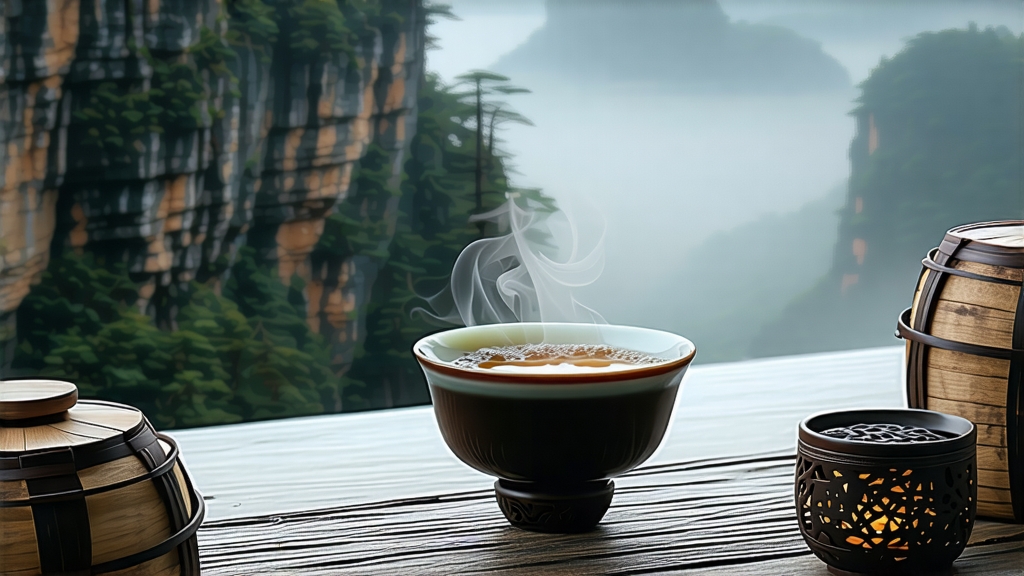
Ask most tea lovers to name the first Chinese black tea and they will probably cite Keemun or Yunnan Gold; historians, however, point to a tiny village in the Wuyi range of northern Fujian where, sometime around 1568, a panicked farmer saved his harvest from marauding soldiers by rapidly drying leaves over fresh pine embers. The accident produced a dark, glossy leaf that smelled of smoked bacon and tasted of longan fruit; it was christened “Lapsang Souchong,” and within fifty years it was traveling the Siberian caravan routes to reach the courts of Moscow, Paris and London. In the process it re-defined “black tea” for the West, gave birth to the word “bohea,” and established the template for every smoky, malty cup that would follow.
Geography and cultivar
The Wuyi Mountains rise like a granite fortress out of Fujian’s subtropical fog; their narrow gorges trap cloud, creating a cool, humid micro-climate that slows leaf growth and concentrates amino acids. The original Lapsang Souchong is picked from the xiao zhong (“small leaf”) cultivar, a close cousin of the tea bushes that give us rock oolong. Only two hamlets—Tongmu Guan and Miaowan—sit high enough (800–1 200 m) and far enough from other gardens to claim protected-origin status; here, the soil is a stony, mineral-rich laterite that drains quickly, forcing roots to dive deep for nutrients and lending the leaf its signature stone-fruit sweetness.
Two styles, one leaf
Today the market offers two distinct faces of Lapsang Souchong. The traditional, pine-smoked version (Chinese labelled “zheng shan xiao zhong”) is still produced in Tongmu Guan between the third week of April and early May. The modern, un-smoked style (“wu yan xiao zhong”) was developed in 2005 for domestic consumers who wanted the honey-like malt of the leaf without the campfire note; it is withered over warm air, oxidised fully, then baked at low temperature. Both share a cocoa-coloured liquor and a lingering dried-longan finish, but only the classic style carries the resinous perfume that once seduced Catherine the Great.
Crafting the smoke
Picking begins at dawn when the dew still weighs the leaf down, ensuring suppleness for the rigorous handling ahead. Two leaves and a bud are plucked, then withered on bamboo trays inside a second-floor loft whose windows are cracked just enough to admit a ribbon of cool mountain air. After six to eight hours the leaf loses about 60 % moisture and emits a light apple aroma; here the paths diverge. For smoked style, the farmer lights a small pile of local Masson pine and Cryptomeria twigs in an earthen pit below the loft. The smoke rises through slats in the floor, infusing the leaf with guaiacol and syringol—the same phenols that give lapsang its trademark bacon note. Every forty minutes the trays are rotated; this continues for ten to twelve hours until the leaf turns a dark tarry green. Next comes rolling: five minutes under mechanical pressure to rupture cells and release enzymes, followed by a twenty-minute rest inside linen sacks where oxidation races from 10 % to 80 % in the tropical heat. Once the leaf smells of ripe peach and copper, it is given a final hot smoke at 90 °C for three minutes to arrest oxidation, then baked very slowly over dying embers for the next eight hours. The result is a jet-black, tightly twisted strip that crackles when you pour it into a tin.
Un-smoked style follows the same withering and rolling steps, but oxidation is done in climate-controlled drums at 24 °C and 85 % humidity; instead of smoke, the leaf is dried with 70 °C clean air, then rested for forty-eight hours to let residual moisture equalise before a gentle 60 °C bake. The cup profile leans toward dark chocolate, raisins and a hint of narcissus flower—closer to a Fujian black than to its smoky sibling.
Buying clues
Authentic Tongmu Lapsang is never cheap: the protected zone caps annual output at roughly 5 000 kg, and every kilo is tracked with a QR code issued by the Fujian Agriculture Department. Look for slender, glossy strips interwoven with golden tips; an absence of dusty crumbs; and a dry aroma that is pine-sweet, not acrid. If the label reads “lapsang souch